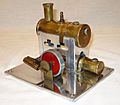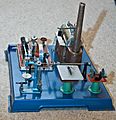Model steam engine facts for kids

A model steam engine is a small steam engine not built for serious use. Often they are built as an educational toy for children, in which case it is also called a toy steam engine, or for live steam enthusiasts. Between the 18th and early 20th centuries, demonstration models were also in use at universities and engineering schools, frequently designed and built by students as part of their curriculum.
Model steam engines have been made in many forms by a number of manufacturers, but building model steam engines from scratch is popular among adult steam enthusiasts, although this generally requires access to a lathe and/or milling machine. Those without a lathe can alternatively purchase prefabricated parts.
Design features
Toy steam engines will commonly have fewer features (such as mechanical lubricators or governors), and operate at lower pressures, while model steam engines will place more emphasis on similarity to life-sized engines. Manufacturers such as Wilesco sell both simple toy engines for beginners (e.g. the D3) and more intricate model engines that are meant to be used to drive things like workshops or boats.
Model steam engines typically use hexamine fuel tablets, methylated spirits (aka meths or denatured alcohol), butane gas, or electricity to heat the boiler. Cylinders are either oscillating (single-acting or double-acting) or fixed cylinder using slide-valves, piston valves or poppet valves (normally double-acting). Spring safety valves and steam whistles are other common features of model steam engines. Some stationary engines also have feedwater pumps to replenish boiler water, allowing them to run indefinitely as long as sufficient fuel is available.
Gallery
-
Model steam engine in the Wolfsonian-FIU museum
Images for kids
-
Weeden Vertical toy steam engine in the 1912 Sears, Roebuck and Co. catalog







